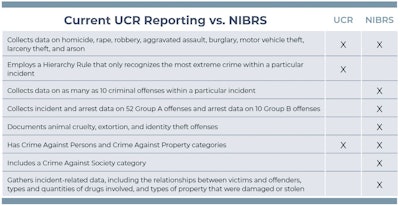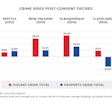By 2021, the Uniform Crime Reports (UCR) program will be retiring and a new crime reporting system will be required across all U.S. law enforcement agencies. Created in 1929 by the International Association of Chiefs of Police (IACP), the UCR Program has been administered by the FBI since 1930 to gather information regarding the nature and volume of crime throughout the United States. The new system, known as the National Incident-Based Reporting System (NIBRS), will completely replace UCR and will ensure agencies are collecting and reporting crime data to the FBI in a more thorough and standardized manner.
Unlike its predecessor, which is now used by only 18,000 agencies nationwide, NIBRS will not be optional and must be implemented by Jan. 1, 2021. While that deadline may seem distant, agencies must be proactive and transition their systems to be NIBRS-compliant sooner rather than later. Aside from the fact that this is a government-mandated program, there are several reasons why agencies should act fast.
While the implementation of a NIBRS-compliant solution should ideally only take an agency three to six months, that time frame does not take into account any errors, bottlenecks, learning curves, and/or training processes that may significantly delay the transition. The sooner your agency commits to making the transition, the easier it will be to handle those road blocks or hiccups in stride and still be on track for the January 1, 2021 deadline.
 This comparison chart illustrates the differences between UCR and NIBRS.
This comparison chart illustrates the differences between UCR and NIBRS.
The first step an agency must take to implement NIBRS is to choose NIBRS-compliant software. This software must adhere to four areas of certification criteria for it to comply:
* System appropriateness: You must provide evidence that your NIBRS reporting software solution follows NIBRS technical specifications by submitting a description of your incident-based system, including submission structure, crime categories, segment relationships, number of offenses collected per incident, and data values allowed per data element. This document will be reviewed by the FBI for program design and concept.
* Updated capability and responsiveness: The software must also demonstrate its ability to update submissions, meet deadlines, respond to FBI queries and requests, and correct errors received from the FBI’s UCR Program in a timely manner.
* Low error rate: Data submissions must be logical and consistent. The FBI measures logic by the percentage of Group A Incident Report submissions containing errors. The FBI defines the error rate as the number of rejected reports over the number of reports submitted and requires a sustained error rate of 4% or less for three separate data submissions.
* Reasonable statistics: Data submissions must be statistically reasonable as a whole (in comparison to national trends). While the error rate assesses the existence of logical mechanical flaws in the data, it does not address data in the aggregate. The FBI’s UCR Program evaluates aggregate data submissions in terms of percent distribution, data trend, volume, and monthly fluctuations.
One very important point to remember about the new crime reporting system is that the Hierarchy Rule no longer applies.
Current UCR data protocol, while it is still valuable, is not all-inclusive due to the application of the Hierarchy Rule. The Hierarchy Rule indicates that only the most serious incident should be reported, causing the actual number of crimes committed to be obscured.
An example of how the Hierarchy Rule is applied in UCR can be seen in an incident in which a criminal breaks into a home, takes the homeowner’s wallet at gunpoint, and ultimately shoots and kills the owner. Under the Hierarchy Rule, the agency only reports the most serious offense: murder. This does not, however, provide an accurate depiction of what actually occurred. NIBRS allows for a more complete, factually correct incident report to be generated.
Perhaps the most important thing you should know about NIBRS is your agency could potentially lose funding if it doesn't implement the system by the Jan. 1, 2021, deadline. This loss of funding could include grants available through the Justice Assistance Grant (JAG) Program and the Office of Community Oriented Policing Services (COPS Office). Agencies that are not compliant may also be ineligible for the Justice Department’s Equitable Sharing Program and the Federal Surplus Equipment Program.
One of the primary benefits of NIBRS is that you can report incidents more rapidly, effectively, and efficiently.
With the UCR reporting system, agencies can only record limited data for 10 offenses, in addition to 20 more crimes where only arrests are reported. With NIBRS, agencies can collect detailed data for up to 52 offenses, along with 10 more offenses where only arrests are reported. These offenses can also now be divided into three incident classifications—Crimes Against Persons and Crimes Against Property classifications have existed previously, but NIBRS now includes a Crimes Against Society category.
No matter the offense, NIBRS records demographic information such as race, ethnicity, age, and sex of victims, arrestees, and known offenders. In contrast, UCR only does this for murder. In addition, NIBRS gathers data on gang involvement, time of day, weapons and force, location, and drug types and quantities.
NIBRS allows for collecting the finer details of an incident, resulting in a clearer, more accurate and overall better description of the crime. The comparison chart illustrates the differences between UCR and NIBRS and is a testament to NIBRS thoroughness.
While the NIBRS implementation process may seem like a tedious task, it is one that will improve the functionality of your law enforcement agency and make for more accurate crime statistics nationwide. Jump on the bandwagon as soon as possible because, in the long run, you’ll be helping to lift all boats – including your own.
Bobby Robertson is CEO of Omnigo Software.












